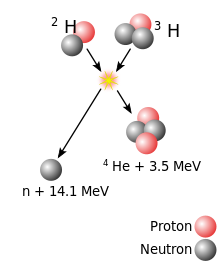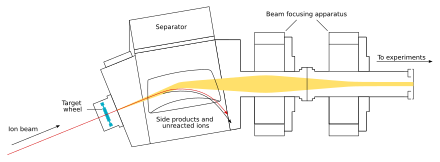Roentgenium
Roentgenium (German: [ʁœntˈɡeːni̯ʊm] ⓘ) is a synthetic chemical element; it has symbol Rg and atomic number 111.
Roentgenium was first created in December 1994 by the GSI Helmholtz Centre for Heavy Ion Research near Darmstadt, Germany.
Roentgenium is calculated to have similar properties to its lighter homologues, copper, silver, and gold, although it may show some differences from them.
[23] The definition by the IUPAC/IUPAP Joint Working Party (JWP) states that a chemical element can only be recognized as discovered if a nucleus of it has not decayed within 10−14 seconds.
This value was chosen as an estimate of how long it takes a nucleus to acquire electrons and thus display its chemical properties.
However, its range is very short; as nuclei become larger, its influence on the outermost nucleons (protons and neutrons) weakens.
[f] Almost all alpha emitters have over 210 nucleons,[36] and the lightest nuclide primarily undergoing spontaneous fission has 238.
[j] Roentgenium was first synthesized by an international team led by Sigurd Hofmann at the Gesellschaft für Schwerionenforschung (GSI) in Darmstadt, Germany, on December 8, 1994.
[56] In 2001, the IUPAC/IUPAP Joint Working Party (JWP) concluded that there was insufficient evidence for the discovery at that time.
Although widely used in the chemical community on all levels, from chemistry classrooms to advanced textbooks, the recommendations were mostly ignored among scientists in the field, who called it element 111, with the symbol of E111, (111) or even simply 111.
[2] The name roentgenium (Rg) was suggested by the GSI team[62] in 2004, to honor the German physicist Wilhelm Conrad Röntgen, the discoverer of X-rays.
A possible synthesis method is to populate them from above, as daughters of nihonium or moscovium isotopes that can be produced by hot fusion.
[69] Calculations on its ionization potentials and atomic and ionic radii are similar to that of its lighter homologue gold, thus implying that roentgenium's basic properties will resemble those of the other group 11 elements, copper, silver, and gold; however, it is also predicted to show several differences from its lighter homologues.
Gold also forms a somewhat stable −1 state due to relativistic effects, and it has been suggested roentgenium may do so as well:[2] nevertheless, the electron affinity of roentgenium is expected to be around 1.6 eV (37 kcal/mol), significantly lower than gold's value of 2.3 eV (53 kcal/mol), so roentgenides may not be stable or even possible.
[70] The 6d orbitals are destabilized by relativistic effects and spin–orbit interactions near the end of the fourth transition metal series, thus making the high oxidation state roentgenium(V) more stable than its lighter homologue gold(V) (known only in gold pentafluoride, Au2F10) as the 6d electrons participate in bonding to a greater extent.
[2] The stability of RgF−6 is homologous to that of AuF−6; the silver analogue AgF−6 is unknown and is expected to be only marginally stable to decomposition to AgF−4 and F2.
[2] Calculations on the molecular compound RgH show that relativistic effects double the strength of the roentgenium–hydrogen bond, even though spin–orbit interactions also weaken it by 0.7 eV (16 kcal/mol).
[2][75] Rg+ is predicted to be the softest metal ion, even softer than Au+, although there is disagreement on whether it would behave as an acid or a base.
[76][77] In aqueous solution, Rg+ would form the aqua ion [Rg(H2O)2]+, with an Rg–O bond distance of 207.1 pm.
[77] Roentgenium is expected to be a solid under normal conditions and to crystallize in the body-centered cubic structure, unlike its lighter congeners which crystallize in the face-centered cubic structure, due to its being expected to have different electron charge densities from them.
[69] Even though the half-life of 282Rg, the most stable confirmed roentgenium isotope, is 100 seconds, long enough to perform chemical studies, another obstacle is the need to increase the rate of production of roentgenium isotopes and allow experiments to carry on for weeks or months so that statistically significant results can be obtained.



